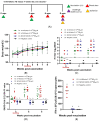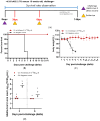Intranasal Administration of Recombinant Newcastle Disease Virus Expressing SARS-CoV-2 Spike Protein Protects hACE2 TG Mice against Lethal SARS-CoV-2 Infection
- PMID: 39204044
- PMCID: PMC11359043
- DOI: 10.3390/vaccines12080921
Intranasal Administration of Recombinant Newcastle Disease Virus Expressing SARS-CoV-2 Spike Protein Protects hACE2 TG Mice against Lethal SARS-CoV-2 Infection
Abstract
Coronavirus disease 2019 (COVID-19), caused by severe acute respiratory syndrome coronavirus-2 (SARS-CoV-2), emerged as a global outbreak in 2019, profoundly affecting both human health and the global economy. Various vaccine modalities were developed and commercialized to overcome this challenge, including inactivated vaccines, mRNA vaccines, adenovirus vector-based vaccines, and subunit vaccines. While intramuscular vaccines induce high IgG levels, they often fail to stimulate significant mucosal immunity in the respiratory system. We employed the Newcastle disease virus (NDV) vector expressing the spike protein of the SARS-CoV-2 Beta variant (rK148/beta-S), and evaluated the efficacy of intranasal vaccination with rK148/beta-S in K18-hACE2 transgenic mice. Intranasal vaccination with a low dose (106.0 EID50) resulted in an 86% survival rate after challenge with the SARS-CoV-2 Beta variant. Administration at a high dose (107.0 EID50) led to a reduction in lung viral load and 100% survival against the SARS-CoV-2 Beta and Delta variants. A high level of the SARS-CoV-2 spike-specific IgA was also induced in vaccinated mice lungs following the SARS-CoV-2 challenge. Our findings suggest that rK148/beta-S holds promise as an intranasal vaccine candidate that effectively induces mucosal immunity against SARS-CoV-2.
Keywords: Newcastle disease virus vector-based vaccine; SARS-CoV-2; SARS-CoV-2 spike-specific IgA; intranasal vaccine; lung viral load.
Conflict of interest statement
The authors declare no conflicts of interest. The funders had no role in the design of this study; in the collection, analyses, or interpretation of data; in the writing of the manuscript, or in the decision to publish the results. The authors Deok-Hwan Kim, Jei-Hyun Jeong, and Chang-Seon Song were employed by the company KHAV. The remaining authors declare that the research was conducted in the absence of any commercial or financial relationships that could be construed as a potential conflict of interest.
Figures





Similar articles
-
Intramuscular administration of recombinant Newcastle disease virus expressing SARS-CoV-2 spike protein protects hACE-2 TG mice against SARS-CoV-2 infection.Vaccine. 2023 Jul 25;41(33):4787-4797. doi: 10.1016/j.vaccine.2023.05.071. Epub 2023 Jun 14. Vaccine. 2023. PMID: 37355454 Free PMC article.
-
Intranasal administration of a single dose of MVA-based vaccine candidates against COVID-19 induced local and systemic immune responses and protects mice from a lethal SARS-CoV-2 infection.Front Immunol. 2022 Sep 12;13:995235. doi: 10.3389/fimmu.2022.995235. eCollection 2022. Front Immunol. 2022. PMID: 36172368 Free PMC article.
-
Intranasal inoculation of an MVA-based vaccine induces IgA and protects the respiratory tract of hACE2 mice from SARS-CoV-2 infection.Proc Natl Acad Sci U S A. 2022 Jun 14;119(24):e2202069119. doi: 10.1073/pnas.2202069119. Epub 2022 Jun 9. Proc Natl Acad Sci U S A. 2022. PMID: 35679343 Free PMC article.
-
An Intranasal OMV-Based Vaccine Induces High Mucosal and Systemic Protecting Immunity Against a SARS-CoV-2 Infection.Front Immunol. 2021 Dec 17;12:781280. doi: 10.3389/fimmu.2021.781280. eCollection 2021. Front Immunol. 2021. PMID: 34987509 Free PMC article.
-
Severe acute respiratory syndrome vaccine development: experiences of vaccination against avian infectious bronchitis coronavirus.Avian Pathol. 2003 Dec;32(6):567-82. doi: 10.1080/03079450310001621198. Avian Pathol. 2003. PMID: 14676007 Free PMC article. Review.
Cited by
-
Glycosylated Receptor-Binding-Domain-Targeting Mucosal Vaccines Protect Against SARS-CoV-2 Omicron and MERS-CoV.Vaccines (Basel). 2025 Mar 10;13(3):293. doi: 10.3390/vaccines13030293. Vaccines (Basel). 2025. PMID: 40266218 Free PMC article.
References
-
- Dixon B.E., Wools-Kaloustian K.K., Fadel W.F., Duszynski T.J., Yiannoutsos C., Halverson P.K., Menachemi N. Symptoms and symptom clusters associated with SARS-CoV-2 infection in community-based populations: Results from a statewide epidemiological study. PLoS ONE. 2021;16:e0241875. doi: 10.1371/journal.pone.0241875. - DOI - PMC - PubMed
-
- World Helth Organiztion WHO Coroanvirus (COVID-19) Dashboard. [(accessed on 2 December 2023)]. Available online: https://covid19.who.int/
-
- van Doremalen N., Lambe T., Spencer A., Belij-Rammerstorfer S., Purushotham J.N., Port J.R., Avanzato V.A., Bushmaker T., Flaxman A., Ulaszewska M., et al. ChAdOx1 nCoV-19 vaccine prevents SARS-CoV-2 pneumonia in rhesus macaques. Nature. 2020;586:578–582. doi: 10.1038/s41586-020-2608-y. - DOI - PMC - PubMed
-
- Corbett K.S., Edwards D.K., Leist S.R., Abiona O.M., Boyoglu-Barnum S., Gillespie R.A., Himansu S., Schäfer A., Ziwawo C.T., DiPiazza A.T., et al. SARS-CoV-2 mRNA vaccine design enabled by prototype pathogen preparedness. Nature. 2020;586:567–571. doi: 10.1038/s41586-020-2622-0. - DOI - PMC - PubMed
Grants and funding
LinkOut - more resources
Full Text Sources
Miscellaneous

